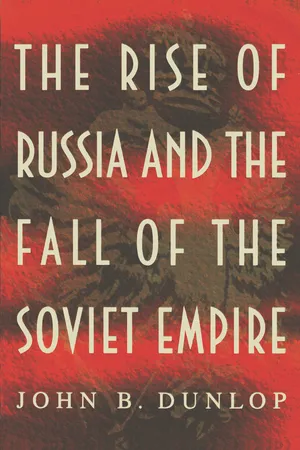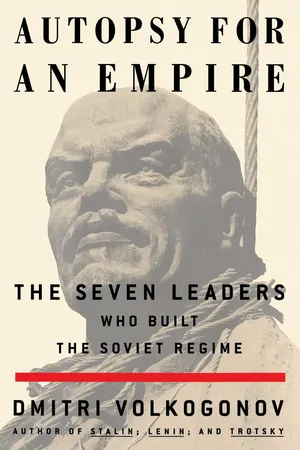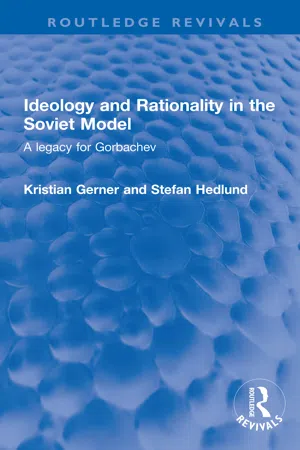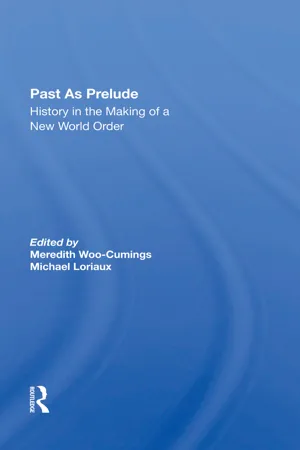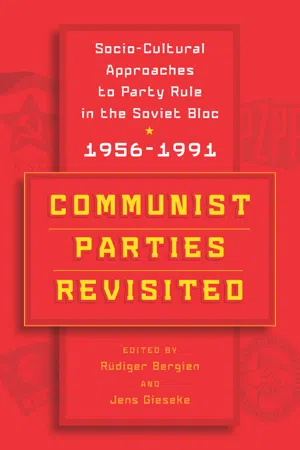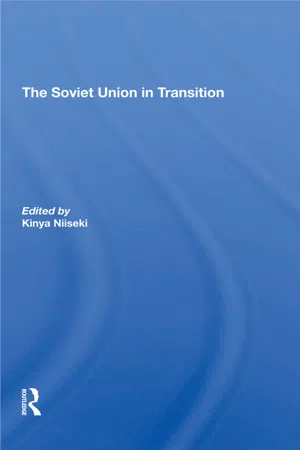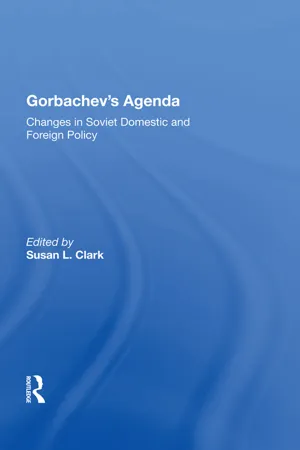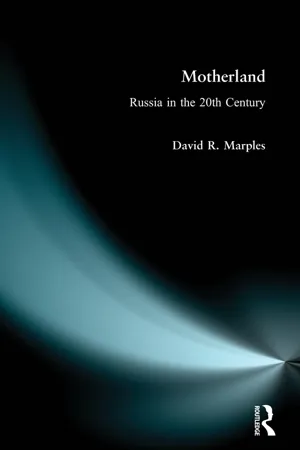History
Mikhail Gorbachev
Mikhail Gorbachev was the last leader of the Soviet Union, serving as General Secretary of the Communist Party from 1985 to 1991. He implemented policies of glasnost (openness) and perestroika (restructuring), which aimed to reform the Soviet political and economic systems. Gorbachev's leadership ultimately led to the dissolution of the Soviet Union and the end of the Cold War.
Written by Perlego with AI-assistance
Related key terms
10 Key excerpts on "Mikhail Gorbachev"
- John B. Dunlop(Author)
- 1995(Publication Date)
- Princeton University Press(Publisher)
1_________________________________________________
Gorbachev and Russia
What is Russia? It is the Union. What is theUnion? It is mostly Russia. (Mikhail Gorbachev) 1What effect did it have on you seeing the red flag come down from the Kremlin? [Gorbachev:] “The same as it did on all thecitizens of this country. The red flag is our life.”2Presumably the last thing that Mikhail Gorbachev wanted to accomplish when he took power in 1985 was to prepare the emergence of an independent Russian state. A committed “Soviet patriot,” Gorbachev believed fervently that the 1917 Revolution had elevated Russia from dreary backwardness to a leading role in world affairs. As he enthused in his programmatic essay, Perestroika , published in 1987: “Russia, where a great Revolution took place seventy years ago, is an ancient country with a unique history filled with searchings, accomplishments, and tragic events. . . .”Gorbachev then continued:However, the Soviet Union is a young state without analogues in history or in the modern world. Over the past seven decades . . . our country has traveled a path equal to centuries. One of the mightiest powers in the world rose up to replace the backward semifeudal Russian Empire. . . . [M]y country’s progress became possible only thanks to the Revolution. . . . It is the fruit of socialism.3Although by 1985 it had become an article of faith among many Western sovietologists that the stormy Nikita Khrushchev, ousted from power in 1964, had been the last Marxist-Leninist “true believer” who was going to rule the Soviet Union, it turned out that they were badly mistaken. Gorbachev, the son of peasants from Stavropol’ krai , it emerged, shared much the same quasi-religious ideological passions and allegiances as did Khrushchev. As the shrewd Montenegrin observer of Soviet politics, Milovan Djilas, noted in 1988: “Gorbachev, unlike Brezhnev, strikes me as a true believer, and I cannot see him [consciously] presiding over the liquidation of communism.”4- eBook - ePub
Autopsy For An Empire
The Seven Leaders Who Built the Soviet Regime
- Dmitri Volkogonov(Author)
- 1999(Publication Date)
- Free Press(Publisher)
Both Yeltsin and Gorbachev were embodiments of the changes taking place in the country. Gorbachev started his utopian effort to ‘renew’ socialism by unwittingly opening the sluice-gates that would wash away the ruins of Leninism. Yeltsin, as the first leader ever to be elected by the entire people in Russia’s long history, had to try to create a modern, democratic society in the midst of ruin and chaos. It was a task no less difficult than liquidating the Communist system.Gorbachev as a Historic Figure
Mikhail Gorbachev launched the most fundamental and irreversible changes in Soviet history since Lenin. Many people still see him as a saviour, while just as many regard him as a destroyer, and those who are indifferent are growing in number. If he does not evoke sympathy among his contemporaries, he has certainly earned the gratitude of future generations.Kerensky, the Russian Prime Minister in post-tsarist 1917, was also underrated, yet in a certain sense what Gorbachev tried to do, perhaps without even realizing it, was to set Russia back on the path that had been started in February 1917 and that was blocked in October by the Bolshevik coup. Like Kerensky, Gorbachev left the scene apparently defeated. But history often awards its laurels many years after the event. Lenin, whom Gorbachev so revered, seemed for seven decades to be the victor, yet the October Revolution was seen by his political enemies, including Kerensky, as the harbinger of inevitable historic defeat. Now, eighty years later, it is clear that they were right.As a historical figure, Gorbachev does not deserve blame, nor does he need vindication; and if he does not want his historical image to be blurred, he should not attempt to blame or vindicate others. A political figure of his stature should be neither prosecutor nor defendant. Having lived for most of his life as an unknown Party official, he remained so until Chernenko’s infirmity compelled the geriatric Politburo to think hard about a younger successor. Gorbachev knew this, and did not force events. His trump card was his age, and he could afford to wait. - eBook - ePub
The 1989 Revolutions in Central and Eastern Europe
From Communism to Pluralism
- Kevin McDermott, Matthew Stibbe(Authors)
- 2015(Publication Date)
- Manchester University Press(Publisher)
Part II The ‘Gorbachev factor’ 3 The multifaceted external Soviet role in processes towards unanticipated revolutions Mary Buckley Mikhail Gorbachev was an essential enabler of revolutions in Eastern Europe. As General Secretary of the Communist Party of the Soviet Union (CPSU) from March 1985, he framed changes and developments and was shaped by them in an unfolding multivariate dynamic. The revolutions were the culmination of complex processes of change, and need to be understood not merely through the events of 1989. At different times, Gorbachev was facilitator, trigger, approver, persuader and loser, throughout tugged in various directions by different political actors and pressures at home, in East Central Europe and internationally. My aims here are: first, to provide an overview of key political signals and messages, both explicit and implicit, that Gorbachev, other leaders and social movements in the USSR gave to East European elites and peoples from 1985 onwards; second, to indicate how Gorbachev interpreted some of the responses and why he had to adopt similar and different approaches to East European states; and, third, to comment briefly on the utility of theories of revolution. Signals, complexities and interactions As initiator of perestroika (restructuring), Gorbachev sent signals to East European leaders that restructuring was not just a domestic policy for the USSR, but one that could be advisedly embraced by them as well. His role in indicating this had, over time, to be multifaceted due to significant variations across these states in their readiness for economic, social and political reform, in their different levels of commitment to change and in special issues that troubled them. At one end of the spectrum, some states in Eastern Europe could be overripe for, or in the process of, change, while at the other lay leaderships thoroughly resistant to it - eBook - ePub
Ideology and Rationality in the Soviet Model
A legacy for Gorbachev
- Kristian Gerner, Stefan Hedlund(Authors)
- 2022(Publication Date)
- Routledge(Publisher)
Part five A legacy for Gorbachev DOI: 10.4324/9781003267201-18Passage contains an image
Chapter fourteen Opening Pandora’s box
DOI: 10.4324/9781003267201-19In March 1985, Mikhail Sergeevich Gorbachev was elevated to the post of General Secretary of the Communist Party of the Soviet Union, and thus also to the leadership of one of the world’s two superpowers. At the age of 54, he was then not only the youngest voting member of the Politburo, he was also the youngest to lead the Party since Stalin’s take-over in the late 1920s. The impression of change and vitality that Gorbachev carried with him into the Kremlin stood in stark contrast to the combined images of his immediate predecessors and he certainly wasted no time impressing upon his audience that a new era had begun. In several major speeches during the following couple of months, he committed himself firmly to a programme of revitalization and reform.At the April 1985 plenum of the Central Committee, for example, he struck a rather alarming note by declaring that ‘the historical fate of the country and the position of socialism in the contemporary world’ depended on whether the Soviet Union was capable of ‘ac-celerating’ its economic growth (uskorenie tempov rosta). He also underlined the need to ‘reconstruct’ (perestroit) management and planning, and stressed that it was essential to accelerate technological and scientific development (kardinalnoe uskorenie nauchno-tekhnicheskogo progressa). Most importantly, perhaps, he called on the mass media to create the necessary conditions for perestroika by ‘organizing and educating the masses and by moulding public opinion’.1Given this dramatic change in climate, it is hardly surprising that many people — both inside and outside the Soviet Union — were taken in by the new image. Hopes for the future, i.e. that the Soviet Union should filially manage to catch up with the West, were on the rise. Paradoxically, however, such expectations seem to have gained a much wider spread and credibility in the West than in the Soviet Union, or — significantly — in the neighbouring East European countries. After a meeting in London in 1984, for example, Margaret Thatcher went on record with the statement that Gorbachev was ‘a man you can deal with’,2 - eBook - ePub
- Seweryn Bialer(Author)
- 2019(Publication Date)
- Routledge(Publisher)
aktiv has in Gorbachev is increasing the longer he stays in power. In this respect his status in the international arena influences his domestic status. The disarmament causes with which he closely identified himself are popular in Russia. Prime Minister Thatcher's symbolic recognition of Gorbachev as an historical figure strengthened his position in the Soviet Union. Similarly, his meetings with President Reagan have had the same effect.Gorbachev's social power base may be broader than his base in the bureaucracy. Those to whom his program offers most, and most immediately, is the Soviet middle class. While this class is educated, it is not powerful. It lives better than the workers, but not dramatically so; and its aspirations are greater than those of the working class. As much has been suggested by the sociologist Tatiana Zaslavskaya, of the Academy of Social Sciences at Novosibirsk, who is closely identified with Gorbachev, when she wrote this year "the most qualified (i.e. professional) part of the population, which carries the burden of the movement of the society as a whole, is precisely the one that will come out ahead in the present situation." As of now, this stratum may not want to risk total support of Gorbachev's program. But the longer he stays in power the more active and supportive they will be.Major reforms in Communist countries display two basic patterns— the incremental and the comprehensive. The Soviet Union and Poland in the 1960s were examples of the first; Hungary and the People's Republic of China are examples of the second. The incremental pattern is characterized by experimentation. Experiments are the enemies of major reforms. Far-reaching reforms must be carried out without hesitation. This is especially so within the generation that will decide the political fate of Gorbachev—his own generation. Most of them entered politics during Khrushchev's anti-Stalinist campaign with great hopes of renewal and then saw their hopes dashed. They are now being given a second lease on life. Their mood, their determination, are a major factor in Gorbachev's progress.Another emotion that is widely represented in the politically active circles in Moscow has an apocalyptic element to it. "This is our last chance," many say. For some, the "last chance" is an expression of patriotic feeling, of the need to make Russia great. For others it is of a last chance to break the dominant pattern of Russian and Soviet history. For still others, it involves the conviction that the Soviet people have suffered too much and too long for the sake of the "glorious future" that never came, and that they are presented with the "last chance" to live better during their own lifetimes. - eBook - ePub
Past As Prelude
History In The Making Of A New World Order
- Meredith Woo-cumings, Michael Loriaux(Authors)
- 2019(Publication Date)
- Routledge(Publisher)
For both, political reforms were valued because they would make the decisionmaking process more rational, enhance the powers of the reformer, and aid in the struggle for reforms in foreign policy and in the economy. Gorbachev, who went much farther down the path of liberalizing Russian politics than did Alexander II, injected the Soviet system with competition, rationalized the political structure of the Soviet Union, created some of the foundations for representative government, and liberalized the role of the media. He did all this for a variety of reasons. In particular, he thought that these reforms were crucial to (1) making decisionmaking more informed, more efficient, and therefore more rational; (2) creating a new body of public officials with some stake in the reform process; (3) enhancing the possibility (rare in recent Soviet history) that policies made would actually be implemented; (4) obscuring all those moves that were in fact not just augmenting his political powers but also creating an institutionalized base for the exercise of those powers; (5) keeping his enemies divided; (6) giving the public and the intelligentsia a stake in the reform process; (7) kicking the state out of the economy by kicking the public into politics; (8) providing a cushion for the costs of economic reform by giving at least some segments of the public more political influence; and (9) mobilizing support in the West for the Soviet reform process in general and for Gorbachev in particular. Thus the political reforms of Gorbachev served a number of strategic functions. 34 Finally, both Gorbachev and Alexander II introduced reforms in foreign policy that were strategic in nature, including such actions as courting Western elite opinion and making alliances in the international system that would, in effect, guard their security during the rigors of domestic reform - eBook - ePub
Communist Parties Revisited
Socio-Cultural Approaches to Party Rule in the Soviet Bloc, 1956-1991
- Rüdiger Bergien, Jens Gieseke(Authors)
- 2018(Publication Date)
- Berghahn Books(Publisher)
The year 1989 not only saw Mikhail Gorbachev well established as the star on the international stage, but was also the year in which his popularity turned to disrespect in the USSR. In the fateful months of 1989, Gorbachev not only lost his power base, the party; he lost control of the political game. The man who had come of age in the ranks of the CPSU and had learned how to maneuver behind the closed doors of party buildings was not made for open political contest. This was also true for the other members of his entourage. Leaving the party to Ligachev and the provincial bigwigs, in 1988 Gorbachev’s close associates had chosen to mostly abandon the brand of secretive Soviet politics they had lived and breathed their entire lives. They created new political and social institutions—a parliament and a public sphere—whose dynamic and open nature they failed to understand. Gorbachev’s promotion to president of the USSR was needed to build an authoritarian counterweight to the pluralism his tenure as general secretary had created. Even so, the attempt to create a government of enlightened experts failed. Gorbachev and his team found the political forces they had unleashed more and more difficult to control.At the very time when Gorbachev tried to use the Soviet state as a power base against his party, that state had begun to disintegrate at its peripheries. In 1990, he was the leader of an empire that had lost its position in Eastern and Central Europe and was starting to lose control over its own outer republics. Gorbachev had turned against the party structures, but had failed to build a new political base. Fatefully, Gorbachev no longer had the requisite influence to reform the centers of power that still existed: the Ministries of Defense and Interior, and the KGB. They continued to exist and, in the long run, proved to be the winners in this political game. The general secretary had managed to discredit the party, but he had not touched other core instruments of authoritarianism; this allowed the Soviet Army and the KGB to make institutional comebacks in the 1990s. By creating the presidency, he established the office that his successor, Boris Yeltsin, would turn into the base of a new Russian autocracy.The CC itself was cut off from power and lost its function after the putsch in the summer of 1991.45 Gorbachev himself slipped from power as the USSR disintegrated and Yeltsin’s team took over the core of the state—the budget, the army, and the Security Services—in the fall of 1991. A study that examines the career of CC employees in post-Soviet Russia remains lacking. While Yeltsin briefly outlawed the Communist Party after the putsch, he and his team certainly needed the expertise of those who knew how Russia was governed, and the seat of administrative power remained: the new president chose to locate his administration at the former CC building at Staraia Ploshchad’. - eBook - ePub
- Kinya Niiseki(Author)
- 2019(Publication Date)
- Routledge(Publisher)
3 "Gorbachevism"—Simply Old Wine in a New Bottle?Hiroshi KimuraSetting
Does change in leadership make a difference in Soviet policy?1 This is a pivotal question and one that almost all specialists on Soviet affairs must consider, given Mikhail S. Gorbachev's succession to the USSR's top leadership post in March 1985. Gorbachev is young, dynamic, and fast-moving—so different from previous incumbents of the general secretaryship. The CPSU's new general secretary has raised expectations among peoples within and outside the Soviet Union to such a level that it is not an overstatement to speak of what might be called "Gorbachev fever," Nevertheless, it is still too early to assess whether Gorbachev will bring any significant, meaningful changes to the Soviet Union.To begin with, we are not yet certain about either the personality or the political orientation of the new general secretary. The most recent edition of the Soviet Great Encyclopedia, published in 1972 (the third edition), did not carry even his name. The 1984 Soviet Encyclopedia (Volume 1) devotes only six lines to describing Gorbachev.2 There is no hard evidence to prove that the new leader is really reform oriented, as has been often reported in the Western media. Gorbachev may well be an authoritarian-type politician (in the Stalinist sense) who likes to see discipline and rigorously executed law and order.3Furthermore, even if we can assume that Gorbachev intends to change the Soviet Union, we cannot be certain that he will succeed in doing so. Whether the new Soviet general secretary will successfully initiate and implement his policies depends upon the environment surrounding him and situations in which he finds himself. Among the "environment and situations" that Gorbachev must reckon with, three stand out.The first is the human environment. There are at least three layers of people with whom the new general secretary must deal. First, he must play a complex power game with his colleagues on the CPSU's Politburo and Central Committee. To be sure, the power and position of the CPSU's general secretary in the Soviet system and practice are quite powerful, far more so than is generally recognized. Yet, the power of the general secretary is not unlimited. Since the demise of Stalin, the general secretary (or the first secretary) of the CPSU has been only one of primus inter pares, - eBook - ePub
Gorbachev's Agenda
Changes In Soviet Domestic And Foreign Policy
- Susan L Clark(Author)
- 2019(Publication Date)
- Routledge(Publisher)
Part IGorbachev’s Reform Efforts and Emerging OppositionIntroduction
The fundamental question facing the Gorbachev leadership today is whether the Soviet Union can actually be reformed. The Western world’s reaction to perestroika, glasnost ,’ and other Soviet initiatives has ranged from persistent skepticism to overwhelming enthusiasm. There is a concern not to miss what may be a valuable opportunity, yet at the same time there is a fear about acting too hastily and finding that we have been gullible. As Robbin Laird explains in his introduction, the best approach is to combine vision with vigilance.Even before addressing the question of whether the Soviet Union can be reformed, it is important to identify what it means to reform. Overcoming the Stalinist legacy is perhaps the greatest challenge facing the Gorbachev leadership. To do so, it will be necessary to overcome fundamental systemic and societal barriers that are prevalent throughout the Soviet Union. And while the initial reason for perestroika lay in the poor performance of the Soviet economy, as Astrid von Borcke and Elizabeth Teague explain, the target of this reform effort has now expanded to affect every aspect of Soviet life. The dilemma for the Gorbachev leadership is deciding how to react to a system that is even more resistant to change than had been imagined.It is equally critical to understand the perceptions of the various players and groups within Soviet society on the issue of perestroika. Von Borcke assesses the attitudes of the KGB, the military, the Ministry of Foreign Affairs, and the Party. Teague analyzes this issue with respect to specified socio-economic groups. Thus, both authors identify a range of support for and opposition to this effort within Soviet society. As Teague concludes, Gorbachev is faced with the dilemma of needing worker support for perestroika - eBook - ePub
Motherland
Russia in the Twentieth Century
- David R. Marples(Author)
- 2014(Publication Date)
- Routledge(Publisher)
Already party membership had begun to decline as prominent and rank-and-file members began to leave in droves. In the first half of 1990, the number of party members who left, no longer paid their dues, or were expelled was close to 800,000 (almost 10 percent of total membership). The situation alarmed party stalwarts and even Gorbachev felt obliged to re-examine his priorities. When Shevardnadze resigned as Foreign Minister in December, he warned of an impending coup d'etat. In fact, Gorbachev began an attempt to regain some of the authority he had lost to the republics. On September 24, the Supreme Soviet granted him the power to rule by presidential decree for 18 months in order to see through his program for economic reform. Yeltsin, meanwhile, had begun an ostentatious "presidential-style" tour of the Russian Federation. In late December when the Congress granted Gorbachev enhanced powers, the president nominated Gennady Yanayev as his Vice-President, a strange choice. Only at the second attempt, and after prolonged persuasion from Gorbachev, could Congress be persuaded to accept it. Yanayev was a dull apparatchik with no interest in reforming the Soviet system. Other appointments made by Gorbachev in the same period did not augur well for the future of a reform program and democracy - Boris Pugo as the chief of police, and Kryuchkov as the head of the KGB, while the loss of Shevardnadze and especially Aleksandr Yakovlev suggested that the president had made a significant about-face. By early 1991, Gorbachev had begun to demand restrictions on freedom of the press. Mass demonstrations in Moscow were banned. The experiment in political change appeared to be over. Gorbachev's challenge, clearly, was the growing power of the republics, and Russia in particular.The Perils of Perestroika
By most calculations, the introduction of Glasnost into Soviet society has to be considered a success, even though the open criticisms of the Gorbachev administration served to lower its credibility and Gorbachev appeared to resent personal attacks on his leadership, Perestroika proved much more difficult. Soviet reports on the economy had never been frank, particularly the reporting of harvests and other economic statistics. The state continued to fix prices for goods and to subsidize struggling firms. There is no doubt that the economy was a key priority for the Soviet leader, but what was the goal of Gorbachev's proposed economic reforms? Was it even possible to reform the archaic system? If so, how far could Gorbachev go? That there should be some decentralization, concessions to local decision-making, redistribution of profits and the like seems self-evident. Constant reiteration of words like "efficiency," "discipline," and "acceleration" are to be found in Gorbachev's early speeches. The obstacles to be overcome, on the other hand, were "bureaucracy" and "formalism." How far could he hope to progress in areas such as agriculture, when the Communist Party elite refused to even consider a dismantling of the collective farm system? Gorbachev, by any standard, was exceedingly unlucky. He could not be held responsible for the fall in world oil prices that had brought an end to the brief boom period of the 1970s. Nor could he do much about the weather, which brought about a series of poor harvest crops. His government had also suffered two unexpected and costly disasters in Chernobyl and the Armenian earthquake. Yet it is hard to avoid the conclusion that he said much but essentially "dabbled" with the economy and the vast ministerial bureaucracies centered in Moscow. Only by 1988 was it evident that he wished to undermine the authority of the Communist Party through more radical changes to the economy and political structure of the country. By that time most Soviet families had already suffered substantial declines in their living standards.
Index pages curate the most relevant extracts from our library of academic textbooks. They’ve been created using an in-house natural language model (NLM), each adding context and meaning to key research topics.
